Data Structures and Algorithms
- Introduction to Data Structures and Algorithms
- Time and Space Complexity Analysis
- Big-O, Big-Theta, and Big-Omega Notations
- Recursion and Backtracking
- Divide and Conquer Algorithm
- Dynamic Programming: Memoization vs. Tabulation
- Greedy Algorithms and Their Use Cases
- Understanding Arrays: Types and Operations
- Linear Search vs. Binary Search
- Sorting Algorithms: Bubble, Insertion, Selection, and Merge Sort
- QuickSort: Explanation and Implementation
- Heap Sort and Its Applications
- Counting Sort, Radix Sort, and Bucket Sort
- Hashing Techniques: Hash Tables and Collisions
- Open Addressing vs. Separate Chaining in Hashing
- DSA Questions for Beginners
- Advanced DSA Questions for Competitive Programming
- Top 10 DSA Questions to Crack Your Next Coding Test
- Top 50 DSA Questions Every Programmer Should Practice
- Top Atlassian DSA Interview Questions
- Top Amazon DSA Interview Questions
- Top Microsoft DSA Interview Questions
- Top Meta (Facebook) DSA Interview Questions
- Netflix DSA Interview Questions and Preparation Guide
- Top 20 DSA Interview Questions You Need to Know
- Top Uber DSA Interview Questions and Solutions
- Google DSA Interview Questions and How to Prepare
- Airbnb DSA Interview Questions and How to Solve Them
- Mobile App DSA Interview Questions and Solutions
DSA Interview Questions
- DSA Questions for Beginners
- Advanced DSA Questions for Competitive Programming
- Top 10 DSA Questions to Crack Your Next Coding Test
- Top 50 DSA Questions Every Programmer Should Practice
- Top Atlassian DSA Interview Questions
- Top Amazon DSA Interview Questions
- Top Microsoft DSA Interview Questions
- Top Meta (Facebook) DSA Interview Questions
- Netflix DSA Interview Questions and Preparation Guide
- Top 20 DSA Interview Questions You Need to Know
- Top Uber DSA Interview Questions and Solutions
- Google DSA Interview Questions and How to Prepare
- Airbnb DSA Interview Questions and How to Solve Them
- Mobile App DSA Interview Questions and Solutions
Data Structures and Algorithms
- Introduction to Data Structures and Algorithms
- Time and Space Complexity Analysis
- Big-O, Big-Theta, and Big-Omega Notations
- Recursion and Backtracking
- Divide and Conquer Algorithm
- Dynamic Programming: Memoization vs. Tabulation
- Greedy Algorithms and Their Use Cases
- Understanding Arrays: Types and Operations
- Linear Search vs. Binary Search
- Sorting Algorithms: Bubble, Insertion, Selection, and Merge Sort
- QuickSort: Explanation and Implementation
- Heap Sort and Its Applications
- Counting Sort, Radix Sort, and Bucket Sort
- Hashing Techniques: Hash Tables and Collisions
- Open Addressing vs. Separate Chaining in Hashing
- DSA Questions for Beginners
- Advanced DSA Questions for Competitive Programming
- Top 10 DSA Questions to Crack Your Next Coding Test
- Top 50 DSA Questions Every Programmer Should Practice
- Top Atlassian DSA Interview Questions
- Top Amazon DSA Interview Questions
- Top Microsoft DSA Interview Questions
- Top Meta (Facebook) DSA Interview Questions
- Netflix DSA Interview Questions and Preparation Guide
- Top 20 DSA Interview Questions You Need to Know
- Top Uber DSA Interview Questions and Solutions
- Google DSA Interview Questions and How to Prepare
- Airbnb DSA Interview Questions and How to Solve Them
- Mobile App DSA Interview Questions and Solutions
DSA Interview Questions
- DSA Questions for Beginners
- Advanced DSA Questions for Competitive Programming
- Top 10 DSA Questions to Crack Your Next Coding Test
- Top 50 DSA Questions Every Programmer Should Practice
- Top Atlassian DSA Interview Questions
- Top Amazon DSA Interview Questions
- Top Microsoft DSA Interview Questions
- Top Meta (Facebook) DSA Interview Questions
- Netflix DSA Interview Questions and Preparation Guide
- Top 20 DSA Interview Questions You Need to Know
- Top Uber DSA Interview Questions and Solutions
- Google DSA Interview Questions and How to Prepare
- Airbnb DSA Interview Questions and How to Solve Them
- Mobile App DSA Interview Questions and Solutions
Low-Level Design of BookMyShow: Object-Oriented Concepts in Action
Imagine booking a movie ticket on BookMyShow during a blockbuster release—millions of users are racing to secure their seats, and the system handles it all without a hitch. How does it do that? The answer lies in its low-level design (LLD), a detailed blueprint that uses object-oriented programming (OOP) principles to create a robust, scalable, and maintainable system. In this post, we’ll explore how BookMyShow’s LLD is crafted, diving into its classes, design patterns, database schema, and concurrency mechanisms. Whether you’re preparing for a technical interview or curious about system design, this guide will provide deep insights and actionable knowledge.
To master system design or other technical skills, sign up for our free courses or get the latest updates by clicking here.
Introduction to BookMyShow
BookMyShow is India’s leading online ticketing platform, enabling users to book tickets for movies, plays, sports events, and more. It connects users with theaters and event organizers, offering a seamless experience for discovering events, selecting seats, and making payments. Behind this user-friendly interface is a complex system that must handle user management, event searches, ticket bookings, payment processing, and notifications—all while ensuring high performance and reliability.
Understanding Low-Level Design
Low-level design (LLD) is the phase of software development where a high-level system design is translated into detailed components, such as classes, interfaces, and their interactions. Unlike high-level design, which focuses on the overall architecture, LLD dives into the nitty-gritty of how the system will be implemented, including code structure, data models, and algorithms. For BookMyShow, LLD involves designing classes for entities like users, movies, theaters, shows, seats, bookings, and payments, and defining how they work together to deliver a seamless experience.
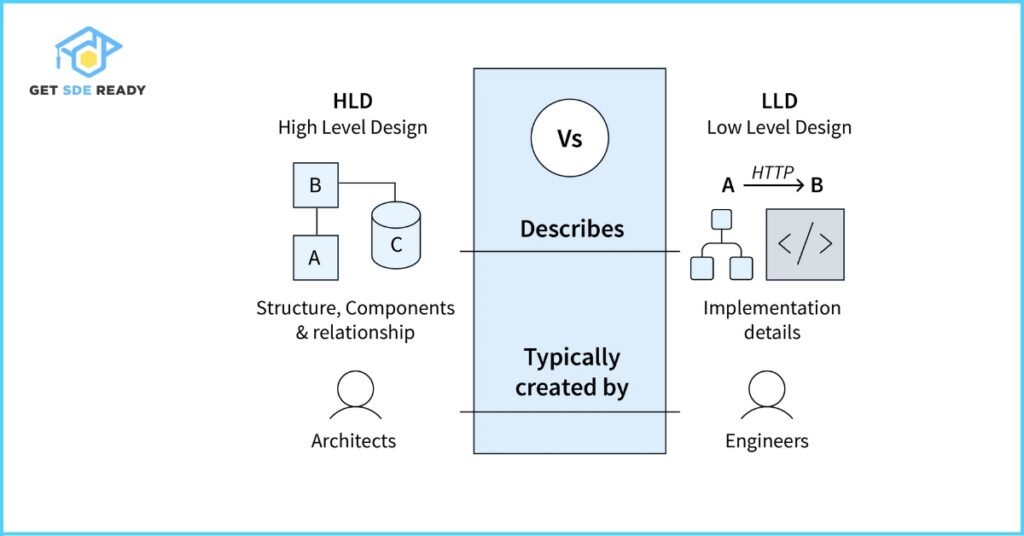
To learn more about data structures and algorithms that underpin such designs, explore our DSA Course.
Object-Oriented Principles in System Design
Object-oriented programming (OOP) is a programming paradigm that uses objects to represent real-world entities. Its core principles are:
- Encapsulation: Bundling data and methods within a class to protect data integrity.
- Abstraction: Hiding complex implementation details and exposing only essential features.
- Inheritance: Allowing new classes to inherit properties and behaviors from existing ones.
- Polymorphism: Enabling objects of different classes to be treated as instances of a common superclass.
These principles ensure that BookMyShow’s code is modular, reusable, and easy to maintain, making it ideal for a system that needs to evolve with new features and user demands.
Designing BookMyShow: Step-by-Step
Let’s break down the process of designing BookMyShow using OOP principles, following a structured approach to object-oriented analysis and design (OOAD).
Identifying Actors
Actors are the users or external systems that interact with BookMyShow. The key actors are:
- Customer: Books tickets and manages their profile.
- Customer Care Representative: Handles customer support queries.
- Front Desk Assistant: Verifies tickets at the venue.
- Theater Administrator: Manages theater details and show schedules.
- System Administrator: Oversees the system, managing user roles and configurations.
Each actor may correspond to a class or role within the system, influencing how functionalities are designed.
Use Cases
Use cases define the system’s functionalities from the user’s perspective. For BookMyShow, key use cases include:
- List cities with affiliate cinemas: Display available cities for ticket booking.
- Search movies and events: Filter by city, date, language, genre, or title.
- Select seats: View and choose available seats for a show.
- Book tickets: Complete the booking process with payment.
- Send notifications: Deliver booking confirmations via email or SMS.
- Manage theater information: Add, update, or remove theaters and shows.
- User management: Handle registration, login, and profile updates.
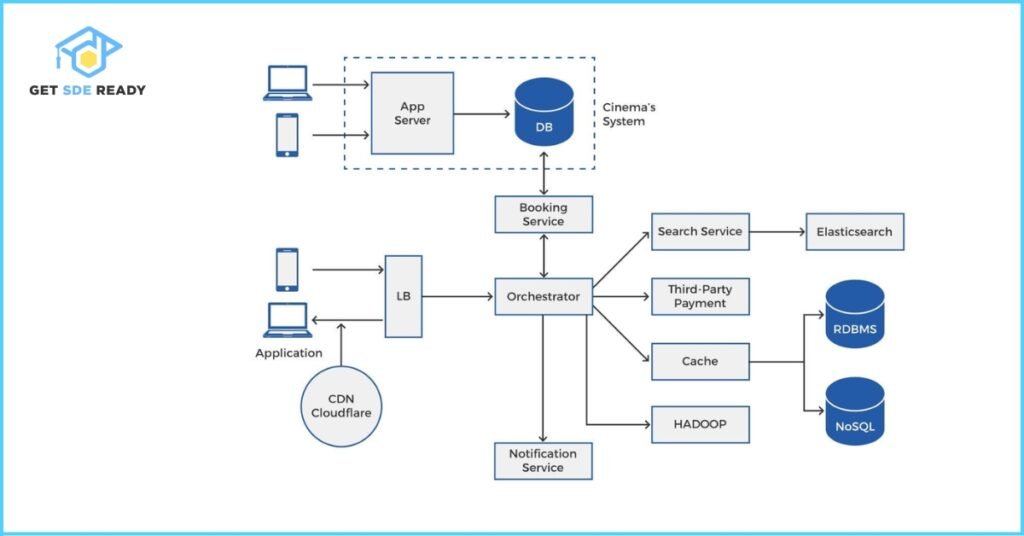
Entities and Classes
Based on the use cases, we identify the main entities to be modeled as classes:
- User: Represents customers, admins, or other roles.
- Movie: Stores movie details like title, genre, and duration.
- Theater: Contains theater information, including location and screens.
- Screen: Represents a specific hall within a theater.
- Show: Defines a movie screening at a specific time and screen.
- Seat: Represents individual seats with types like regular or premium.
- Booking: Manages ticket reservations for users.
- Payment: Handles payment transactions.
- Notification: Sends confirmations and reminders.
Relationships Between Classes
The relationships between classes define how they interact:
- A Theater has multiple Screens.
- A Screen contains multiple Seats.
- A Show is associated with one Movie, one Screen, and specific StartTime and EndTime.
- A Booking links a User to a Show and one or more Seats.
- A Payment is tied to a Booking.
- A Notification is sent to a User after a booking or other events.
These relationships ensure that the system’s components work cohesively.
Key Classes and Their Responsibilities
Here’s a detailed look at the key classes and their roles in BookMyShow’s LLD:
- User Class:
- Attributes: userId, name, email, phone, role (e.g., customer, admin)
- Methods: register(), login(), updateProfile(), getBookingHistory()
- Movie Class:
- Attributes: movieId, title, genre, language, duration, rating
- Methods: getDetails(), searchMovies(filter)
- Theater Class:
- Attributes: theaterId, name, location, list of screens
- Methods: addScreen(), removeScreen(), getAvailableShows()
- Screen Class:
- Attributes: screenId, theaterId, name, capacity
- Methods: getSeats(), addSeat()
- Show Class:
- Attributes: showId, movieId, theaterId, screenId, startTime, endTime
- Methods: getAvailableSeats(), bookSeats(seatIds)
- Seat Class:
- Attributes: seatId, screenId, seatNumber, type (regular, premium, accessible, recliner), status (available, booked, locked)
- Methods: lockSeat(), releaseSeat(), confirmBooking()
- Booking Class:
- Attributes: bookingId, userId, showId, seatIds, status (pending, confirmed, checked_in, canceled), paymentId
- Methods: initiateBooking(), confirmBooking(), cancelBooking()
- Payment Class:
- Attributes: paymentId, bookingId, amount, status (unpaid, pending, completed, declined, canceled, refunded), method (cash, credit_card)
- Methods: processPayment(), refund()
- Notification Class:
- Attributes: notificationId, userId, message, type (email, SMS), status
- Methods: sendNotification(), trackStatus()
For hands-on practice with coding such systems, consider our Web Development Course.
Design Patterns Applied
Design patterns provide reusable solutions to common problems in software design. BookMyShow leverages several patterns:
- Singleton Pattern: Ensures a single instance of services like UserService or ConfigurationManager, useful for managing global states.
- Factory Pattern: Creates objects like payment gateways (e.g., PayPal, Stripe) based on user selection.
- Strategy Pattern: Implements different search algorithms (e.g., by city, genre) for flexible filtering.
- Observer Pattern: Notifies users when seats are booked or released, or when a show is about to start.
- Command Pattern: Encapsulates booking actions, enabling undo/redo functionality.
- Adapter Pattern: Integrates third-party payment gateways with the system’s payment service.
For example, the Observer Pattern is critical for seat locking: when a user locks seats, the system notifies other users if those seats become available again.
Database Schema
The database schema for BookMyShow includes tables that map to the main entities:
Table | Fields |
User | userId (PK), name, email, phone, role |
Movie | movieId (PK), title, genre, language, duration, rating |
Theater | theaterId (PK), name, location |
Screen | screenId (PK), theaterId (FK), name |
Seat | seatId (PK), screenId (FK), seatNumber, type, price |
Show | showId (PK), movieId (FK), theaterId (FK), screenId (FK), startTime, endTime |
Booking | bookingId (PK), userId (FK), showId (FK), status, paymentId (FK) |
Payment | paymentId (PK), bookingId (FK), amount, status, method |
Notification | notificationId (PK), userId (FK), message, type, status |
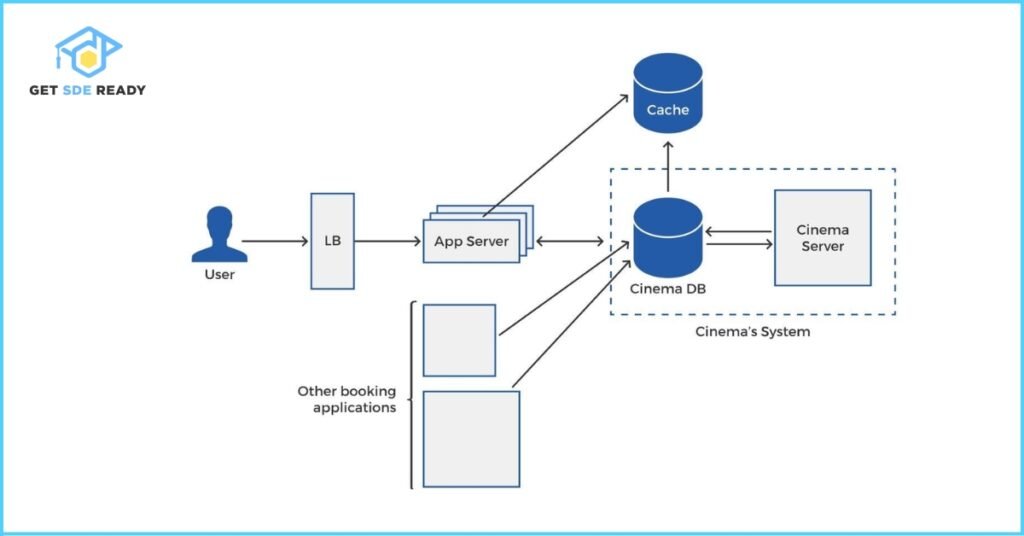
This schema ensures efficient data storage and retrieval, supporting the system’s functionalities.
Concurrency and Scalability Considerations
BookMyShow must handle high concurrency, especially during peak times like movie releases. Key considerations include:
- Seat Locking Mechanism: Seats are locked for a short period (e.g., 10 minutes) when a user selects them, preventing double bookings. The Observer Pattern can notify other users when locks expire.
- Database Transactions: Booking and payment processes are atomic to maintain data integrity.
- Caching: Frequently accessed data, like movie details or theater information, is cached using tools like Redis to reduce database load.
- Load Balancing: Traffic is distributed across multiple servers using tools like Nginx to handle high loads.
- Microservices Architecture: The system is split into independent services (e.g., user service, booking service) that can be scaled separately.
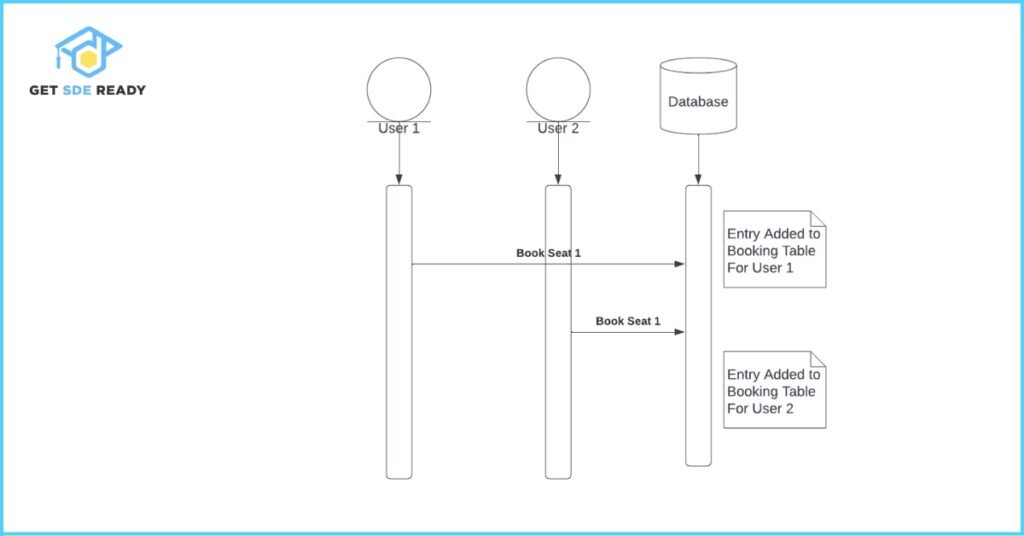
For a deeper dive into scalability and performance optimization, check out our System Design Course.
APIs for BookMyShow
To support its functionalities, BookMyShow relies on a set of RESTful APIs. Here are some essential APIs:
API | Description |
POST /api/users/register | Registers a new user with name, email, and phone. |
POST /api/users/login | Authenticates a user and returns a session token. |
GET /api/movies?city={cityName} | Lists movies available in a specified city. |
GET /api/shows?movieId={movieId}&city={cityName} | Lists shows for a movie in a city. |
GET /api/seats?showId={showId} | Retrieves available seats for a show. |
POST /api/bookings/lock | Locks selected seats for a user for a limited time. |
POST /api/bookings/confirm | Confirms a booking after payment. |
POST /api/payments | Processes a payment for a booking. |
These APIs ensure smooth interaction between the front-end and back-end, built using technologies like ReactJS and Spring Boot. For more on building such APIs, explore our Web Development Course.
Technologies Used
BookMyShow’s tech stack includes:
- Front-End: ReactJS, Bootstrap for a responsive UI.
- Back-End: Java, Spring Boot, Hibernate for robust server-side logic.
- Database: MySQL for structured data storage.
- Caching: Hazelcast or Redis for performance optimization.
- Notifications: RabbitMQ for sending emails and SMS.
- Payment APIs: PayPal, Stripe, Square for secure transactions.
- Deployment: Docker, Ansible for scalable infrastructure.
- Logging: Log4J, ELK Stack for monitoring and debugging.
For those interested in data-driven systems, our Data Science Course covers relevant technologies.
Conclusion
Designing a system like BookMyShow requires a deep understanding of object-oriented principles, design patterns, and system architecture. By carefully defining actors, use cases, and classes, and applying patterns like Singleton, Factory, and Observer, we can create a system that is modular, scalable, and maintainable. Concurrency mechanisms like seat locking and scalability techniques like caching and load balancing ensure a seamless user experience.
If you’re preparing for technical interviews or want to master system design, our System Design Course and Crash Course offer hands-on practice and expert guidance.
FAQs
What is low-level design in system design?
Low-level design (LLD) involves breaking down a high-level system design into detailed components like classes and interfaces, focusing on implementation details.
How are object-oriented principles applied in BookMyShow’s design?
OOP principles like encapsulation, abstraction, inheritance, and polymorphism create modular and reusable code for entities like movies, bookings, and payments.
What design patterns are used in BookMyShow’s system?
Patterns like Singleton, Factory, Strategy, Observer, Command, and Adapter handle tasks like global state management, object creation, and third-party integrations.
How does BookMyShow prevent double booking of seats?
It uses a seat locking mechanism, temporarily reserving seats for a user and releasing them if the booking isn’t completed within a set time.
What technologies power BookMyShow’s system?
Technologies include ReactJS for the front-end, Spring Boot for the back-end, MySQL for the database, and tools like Redis and RabbitMQ for caching and notifications.
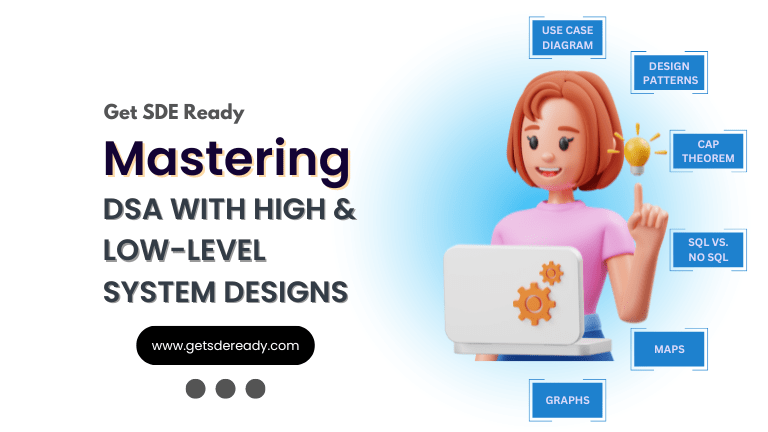
DSA, High & Low Level System Designs
- 85+ Live Classes & Recordings
- 24*7 Live Doubt Support
- 400+ DSA Practice Questions
- Comprehensive Notes
- HackerRank Tests & Quizzes
- Topic-wise Quizzes
- Case Studies
- Access to Global Peer Community
Buy for 60% OFF
₹25,000.00 ₹9,999.00
Accelerate your Path to a Product based Career
Boost your career or get hired at top product-based companies by joining our expertly crafted courses. Gain practical skills and real-world knowledge to help you succeed.
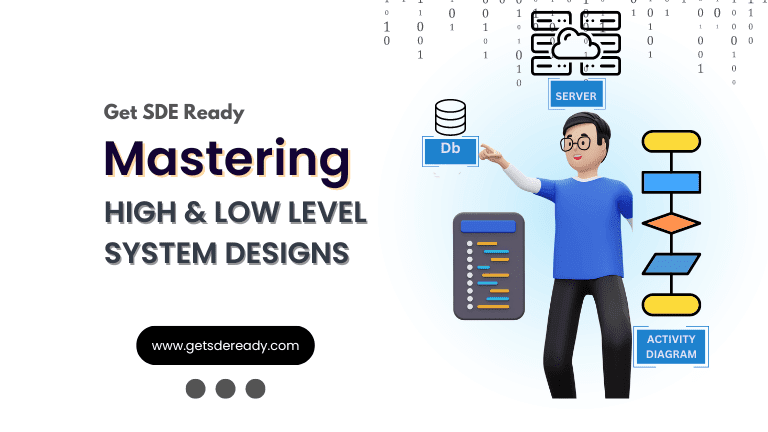
Low & High Level System Design
- 20+ Live Classes & Recordings
- 24*7 Live Doubt Support
- Case Studies
- Comprehensive Notes
- HackerRank Tests
- Topic-wise Quizzes
- Access to Global Peer Community
- Interview Prep Material
Buy for 65% OFF
₹20,000.00 ₹6,999.00
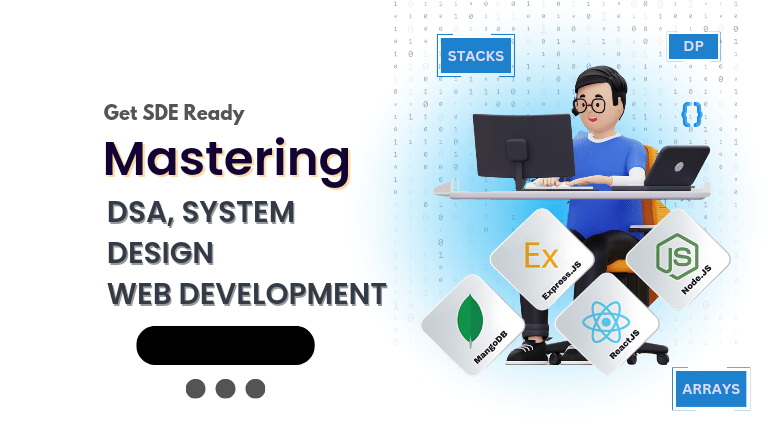
Fast-Track to Full Spectrum Software Engineering
- 120+ Live Classes & Recordings
- 24*7 Live Doubt Support
- 400+ DSA Practice Questions
- Comprehensive Notes
- HackerRank Tests & Quizzes
- 12+ live Projects & Deployments
- Case Studies
- Access to Global Peer Community
Buy for 57% OFF
₹35,000.00 ₹14,999.00

DSA, High & Low Level System Designs
- 85+ Live Classes & Recordings
- 24*7 Live Doubt Support
- 400+ DSA Practice Questions
- Comprehensive Notes
- HackerRank Tests & Quizzes
- Topic-wise Quizzes
- Case Studies
- Access to Global Peer Community
Buy for 60% OFF
₹25,000.00 ₹9,999.00
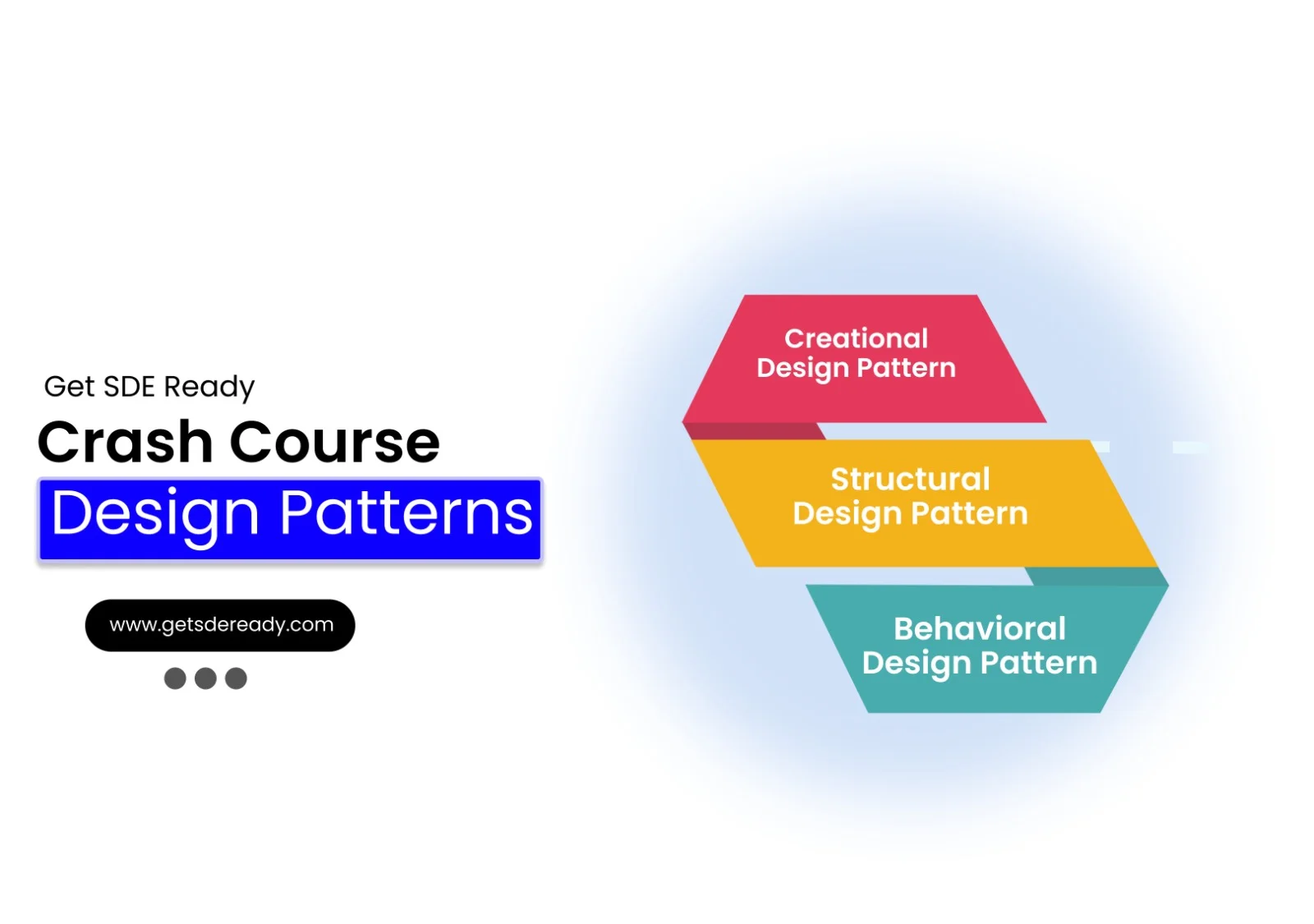
Design Patterns Bootcamp
- Live Classes & Recordings
- 24/7 Live Doubt Support
- Practice Questions
- Case Studies
- Access to Global Peer Community
- Topic wise Quizzes
- Referrals
- Certificate of Completion
Buy for 50% OFF
₹2,000.00 ₹999.00
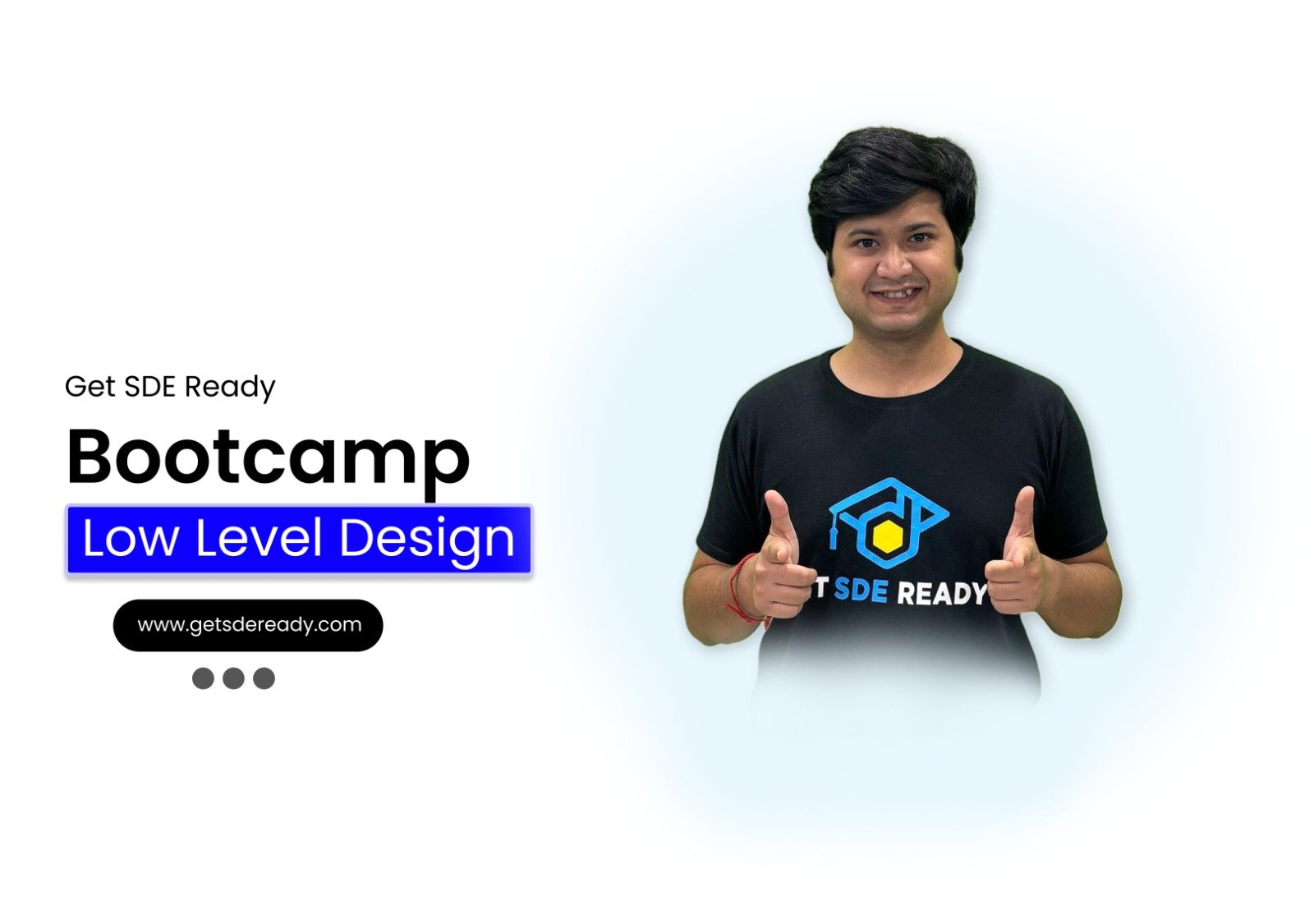
LLD Bootcamp
- 7+ Live Classes & Recordings
- Practice Questions
- 24/7 Live Doubt Support
- Case Studies
- Topic wise Quizzes
- Access to Global Peer Community
- Certificate of Completion
- Referrals
Buy for 50% OFF
₹2,000.00 ₹999.00
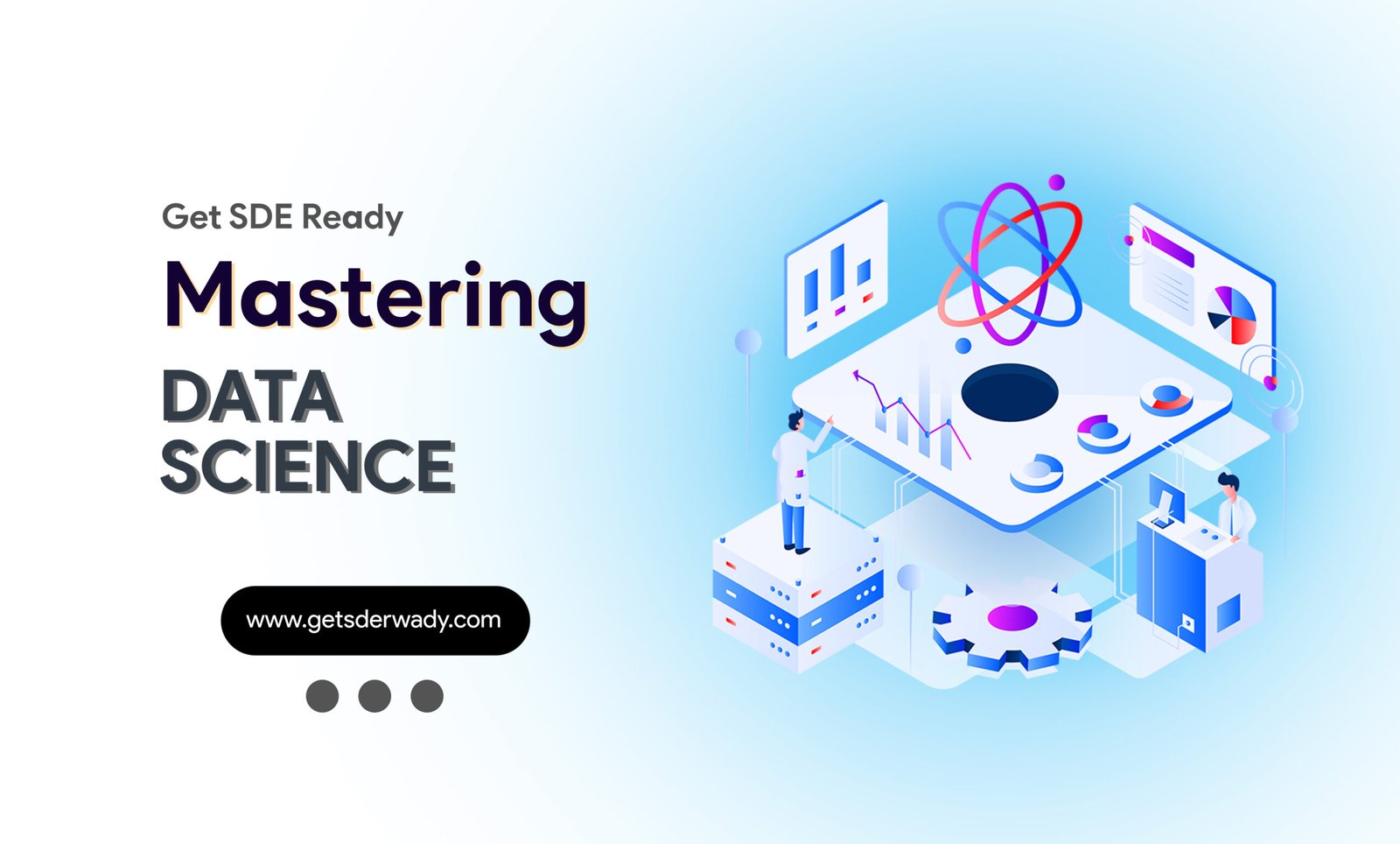
Essentials of Machine Learning and Artificial Intelligence
- 65+ Live Classes & Recordings
- 24*7 Live Doubt Support
- 22+ Hands-on Live Projects & Deployments
- Comprehensive Notes
- Topic-wise Quizzes
- Case Studies
- Access to Global Peer Community
- Interview Prep Material
Buy for 65% OFF
₹20,000.00 ₹6,999.00
Reach Out Now
If you have any queries, please fill out this form. We will surely reach out to you.
Contact Email
Reach us at the following email address.
arun@getsdeready.com
Phone Number
You can reach us by phone as well.
+91-97737 28034
Our Location
Rohini, Sector-3, Delhi-110085